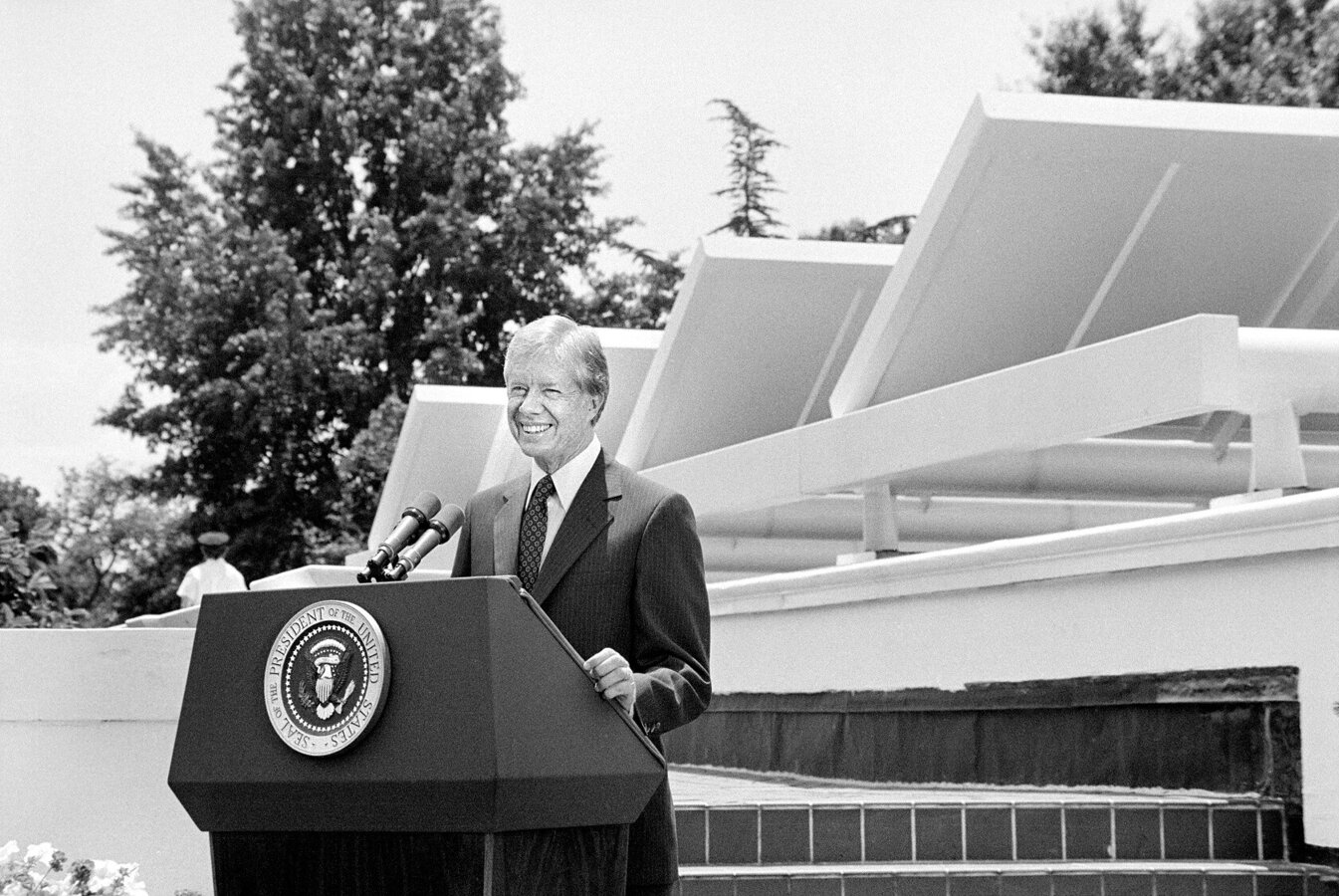
USA in the past
How will they heat the water in the White House?
The start of the Trump Era, the farewell to Carter by the five living US presidents, the 1979 solar panel roof removed by Reagan, and China. When presidential anecdotes tell us about the era we live in (including environmentally)
8 minThe United States of America has recently experienced some important collective moments: the official confirmation of the presidential election before Kamala Harris, President of the Senate and losing candidate, the swearing in of Trump and Vance, the start of a new adventure in government for the Republicans and in opposition for the Democrats. The somewhat melancholy farewell of Biden, who has been a Capitol Hill staple for nearly fifty years in many different roles.
B
ut also the collective ritual celebrated with all five living presidents for the funeral of Jimmy Carter, which also preceded these moments, which received a lot of attention around the world. For Jimmy Carter, who certainly did not have an easy presidency—which moreover ended with the unresolved issue of the Americans from the US embassy in Tehran taken hostage by supporters of Khomeini's Islamic Revolution in its early stages—in the nearly fifty years since, lived around the world, committed to peace and human rights, earning unanimous and largely bipartisan admiration.
Carter and the environmental movements
The patchwork of memories and anecdotes revealed a politician who was environmentally conscious as far back as the almost prehistorical 1979. It was in that year that, after learning as a US senator about the economic crises that led to the 1973 oil crisis, the global takeover by OPEC, and states that were suddenly no longer "developing" but became rich in economic opportunity, he not only listened to the fledgling environmental movements at a time when even Greta Thunberg's parents were perhaps not yet dating, but he really took them seriously. And, first among the world's powers, he had a solar system installed—at the time really very simple and rudimentary—in the left wing of the White House, for the purpose of producing hot water and predicting that within a few years it would be a useful method not only for the most powerful Head of State of a nation that had proudly sought to compete even for scientific research and the conquest of Space, but a widespread method used by the US and world population.
Vintage photos show him small, alone at the podium, in front of a wing of the White House all occupied by no less than 32 very large, raised panels on the White House roof, all facing statically toward the rising sun. Objectively what an architect might disdainfully call an architectural "excrescence".
Reagan's choice
It was ugly to look at and very rigid. Not so much for ideological reasons but mainly because of his idea of harmony and preservation of the existing as he had found it (in his westerns especially), Reagan had them removed in 1986, and anyone wanting to know more about them today can find only one of the 32 solar panels of the very first and primitive Cartesian generation in the Smithsonian National Museum of American History.
Actually, two others were saved: one is obviously in the Carter Foundation but another even more curiously, according to the New York Times, is in the collection of the Museum of Solar Technology and Energy in Dezhou, China. Never was such a presence more unthinkably prophetic, considering that China, which of course as we know has presidential cycles somewhat longer than four years.... is now the superpower in this field, with roughly eighty percent of production in the global solar panel industry.
A
s much as he was a Democrat open to the world, Carter's vision certainly did not go so far as to envision this role for China, at least then and as president. But in presenting this installation to the White House, he went so far as to say that solar power from 1979 to 2000 would have provided at least 20 percent of energy in the US. And here he was not far from reality because indeed solar in the United States is now around twenty percent of total production. However, it is not a good result, seen with today’s eyes and considering everything that has happened since 1979 and the giant strides that research, and research applied to the energy sector, have made in nearly fifty years.
What history teaches us
The reflection goes beyond Carter and the curious fact that nevertheless has its own historical value, given that it is already remembered in museums. The reflection is almost one of political science or political philosophy. How should political and government administrations deal with science, innovative proposals, and technological challenges?
At the moment, it seems clear that states with a high degree of democracy run the risk to which the US presidency has exposed itself for solar: Carter yes, Reagan neither yes nor no/no, Bush senior neither/yes, Clinton yes, Bush junior neither/yes, Obama definitely yes, Trump definitely no, Biden yes, future Trump predictably more no than neither. In all of this, the US has lost technological primacy to China and is lagging behind along with some very wealthy Arab countries that today have both the sunshine but also the money to buy cutting-edge technologies.
It is the price of democracy but it is perhaps the price to reflect on in building a non-ideological continuity of administrations of democratic countries. In the US it is more noticeable, but it is also worth reflecting on in the European Union and its states albeit with less innovative or productive strength than the US, at least individually.
W
ith the exception of the United Kingdom, where the push for a reduction in the burden of coal, the “dirty” nuclear power of the past and a certain openness to energy innovation has been an incidental carryover in all administrations—Conservative or Labour (and more so in the relationship with the Liberals) over the same period of time. And Brexit or no Brexit, so much so that the UK's good rate of energy innovation today risks weighing on post-Brexit rates in the European Union.
How will they heat the hot water in the White House today, so many years after Jimmy Carter’s spontaneous and innovative action? We are waiting to find out in Trump 2...at the moment we only know that, since Bush, the Christmas trees are no longer decorated with traditional electric lights but solar-powered LEDs. At least as far as Christmas 2024.

